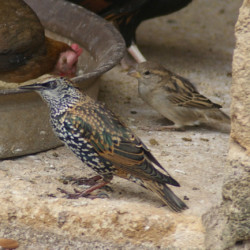Plants and Animals
BirdsCorals
Fish
Plants
Learn
BZS Schools' ProgrammeVisiting School Groups
Camps
Youth and Teen Programmes
Adult and Young Adult Programmes
Guides and Resources
Plants and Animals
Contact
General Inquiries
info@bzs.bm
Birds

Habitats Invaded:
Since it arrived in Bermuda in the 1950s, from the U.S.A. to where it had been introduced from Europe, the Starling increased only slowly for the first 50 years or so. Since then it has prospered and invaded all terrestrial habitats in Bermuda. It is common in town and country alike, sometimes in large flocks. It is numerous in the city and adept at finding discarded human food. It occupies, among others, the same habitat as the Eastern Bluebird (Sialia sialis) and there competes strongly for food and space. It nests in holes in trees, walls, cliffs and buildings.
Characteristics:
Although the Starling is generally disliked, it is really rather a pretty bird with very iridescent feathers, particularly in breeding season (over). Starlings are dark birds, some are almost black, but there is a good deal of variation and always some speckling all over the body (right). Juvenile birds are very speckled and considerably lighter than the adults. The beak is dark except in breeding season when it is yellow. Starlings most frequently feed on the ground often with sparrows and will consume almost anything they can find that does not escape them. In the autumn, large flocks of juvenile birds often appear in open ground such as fields and the airport. The Starling grows to about 8 1⁄2 inches or 22 centimetres.
Origin:
This bird originated in Eurasia and North Africa then spread throughout Europe. However, it does not naturally cross oceans so until man started to travel, it stayed relatively confined. However, man crossing the Atlantic and other oceans brought Starlings and now they are virtually world-wide.
Conservation Importance:
The most serious conservation aspect of Starlings is their competition with Bluebirds. They occupy the same habitats and compete there for both space and food, and the Starling is a very successful competitor. This harmful aspect of Starling behaviour is heightened by the presence of House Sparrows (Passer domesticus), which further stress Bluebirds by occupying both natural nest sites and nest boxes. Another conservation aspect is that Starlings spread the seeds of several invasive plants, such as the Brazil Pepper (Schinus terebinthifolius) and Fern Asparagus (Asparagus densiflorus). Large numbers are also a problem in that their droppings can foul frequented areas.


